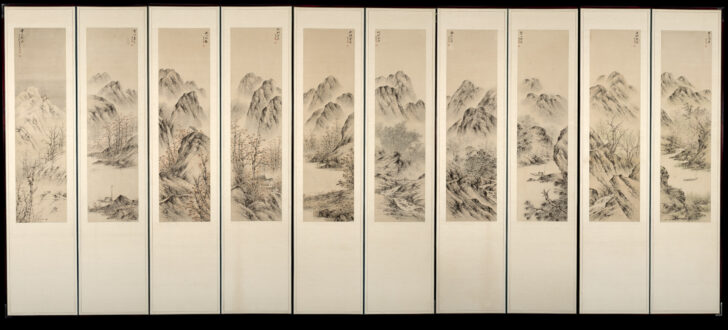Landscape of the Seasons
Yi Sang-Beom

Description
Yi Sang-Beom
Korea, 1899–1978
Landscape of the Seasons
1943
Ten-fold screen with ink and color on paper
Gift of Dr. & Mrs. Seong H. Chi, 2007/2.10
Yi Sangbeom considered painting to be a reflection of the
spirit. While he trained in traditional Chinese and Japanese
painting, he was also familiar with the newly popular
Western styles of art and sought to establish a personal
style with which to portray the Korean landscape. This ten-
panel screen reflects Yi’s experiments. Although he chose
a traditional Chinese subject, his brushstrokes are thinner
and softer. His use of fog and dusk to suggest receding
space between the mountain ridges reveals the influence of
Western styles.
Each of the panels represents a season, beginning with
spring on the right and ending with winter on the left. The
spring panel is titled “The Joy of Fishing on a Spring River,”
evoking the tranquil, scholarly life idealized by Korean
literati artists, who modeled themselves after Chinese
scholar-artists.
Subject Matter:
Mountain scene over depicted on ten folding screen panels over the changing seasons.
Physical Description:
Ten-panel screen depicting similar mountain scenes over changing seasons. A spring scene begins on the right, gradually changing over the ten images to winter on the left. In an upper corner of each scene is a corresponding seasonal poetic inscription. These images are created using ink and color on paper, which was mounted on the upper two-thirds of each panel of the screen.
Artist Yi Sangbeom has chosen a traditional theme, “Eight Views of Xiao and Xiang Rivers (瀟湘八 景圖),” but this painting is infused with a Korean mood by his unique expression and brush strokes. This ten-panel folding screen depicts various landscapes in each of the four seasons (四季山水圖): panels 1 to 3 depict spring landscapes; panels 4 and 5 summer; panels 6 to 8 autumn; and panels 9 and 10 winter. The title (畵題) of each panel is written on its upper corner. Beginning from the first panel on the far right, the titles are as follows: “The Joy of Fishing on a Spring River (春江漁樂),” “Spring Haze in the Mountain Forest (山林春煙),” “Clear Dawn in Jade-green Mountains (碧山淸曉),” “Mountain Lodge after Rain (雨後山莊),” “Remote Shelter in a Dense Bamboo Forest (竹深幽居),” “Autumn Fog among Layered Mountain Peaks (秋煙疊嶂),” “Remote Pavilion in an Autumn Forest (秋林幽亭),” “Evening Mood in the Heart of Autumn (秋心晩趣),” “Colors of Dusk on a Cold River (寒江暮色),” “Homebound Traveler in Snowy Mountains (雪山歸旅).” Yi’s pen name, Cheongjeon (靑田), is written under the title along with the imprints of two seals carved with his name and pen name, “Sangbeom (象範)” and “Cheongjeon (靑田).” The tenth panel contains the inscription “painted by Cheongjeon in spring of the year Gyemi (癸未新春靑田寫),” informing us that the painting was produced in spring of 1943.
[Korean Collection, University of Michigan Museum of Art (2017), 226-227]
Usage Rights:
If you are interested in using an image for a publication, please visit https://umma.umich.edu/request-image/ for more information and to fill out the online Image Rights and Reproductions Request Form.